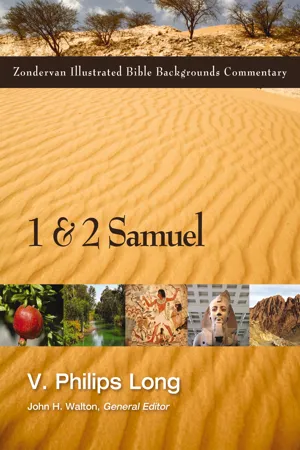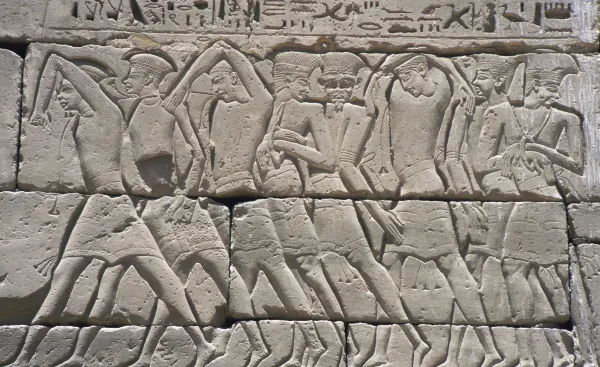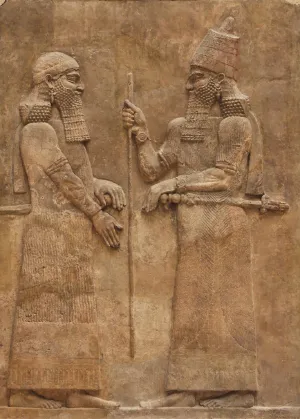![]()
1 Samuel
by V. Philips Long
Introduction1
Few Old Testament books have attracted more attention than 1 and 2 Samuel, and for good reason! The stories of Hannah, Eli, Samuel, Saul, David, Absalom, and many others are riveting, often praised as among the finest narratives to be found anywhere in world literature.2 In addition, the events that these books trace—namely, those involved in Israel’s transition from tribal league to monarchy—are among the most momentous in the history of ancient Israel. Given the societal and theological ramifications of these changes—and especially in the light of the prominent place that the famous king David occupies in them—it is hard to overstate the significance of the books of Samuel.
But 1 and 2 Samuel were written long ago and in a culture different in many respects from the world in which we live. In order to understand them, therefore, and to discern their historical and theological import, we must discover what we can of the cultural context in which these books took shape. Our focus in what follows will be on how knowledge of the ancient Near Eastern cultures and literatures of Israel’s near and far neighbors can elucidate our understanding of the text and how the growing body of archaeological knowledge can help us understand the places and “life-ways” that figure in the biblical narratives. Before launching into our specific explorations of the texts, a few general comments about the historical and literary settings of these two books are in order.
Historical Setting
The events described in 1 and 2 Samuel took place in the eleventh and early tenth centuries B.C. This time period (which archaeologists call Iron Age I, ca. 1200–1000 B.C.) was one in which the superpowers of the preceding Bronze Ages had little impact in Syria-Palestine. The Anatolian kingdom of the Hittites had been essentially destroyed by “the ‘Sea Peoples’ and other land-based movements.”3 The Egyptians exercised limited control along the coast of Canaan until the mid-twelfth century and then withdrew.4 The Assyrians were occupied with troubles closer to home, especially their rivalry with Babylonia to their south. The Assyrian king Tiglath-pileser I did push as far westward as the northern Mediterranean coast near the end of the twelfth century, defeating some Aramean territories along the way, but he did not move southward into Palestine itself.
Babylonia, too, was incapable at this time of giving much attention to Syria-Palestine, finding plenty to keep it busy protecting its interests against neighboring Assyria and Elam.5 Thus, as 1 Samuel opens, the land in which the Israelites are set was experiencing an eclipse of the Great Powers. Conditions were ripe for the emergence of smaller territorial powers—mini-empires, as Kitchen calls them6—such as the kingdom ascribed to David in the text of Samuel (see sidebar on “The ‘Empire’ of David” at 2 Sam. 8).
The transition to monarchy was a new departure in the political and religious life of tribal Israel. But it was not a surprising or unanticipated development. The concept of kingship was well known in the ancient Near East from at least early in the third millennium and was widely practiced not only by the major powers in Egypt, Anatolia, and Mesopotamia, but also by Israel’s immediate neighbors, whose kings are regularly mentioned (e.g., Judg. 3:8, 12; 4:2; 8:5).7 The Israelite tribes themselves had experienced at least one abortive attempt to introduce monarchy (i.e., Abimelech in Judg. 9).
The opening books of the Bible, moreover, clearly hint of a coming time in which Israel will have a human king (e.g., Gen. 49:10; Num. 24:7, 17–19). In Deuteronomy, Moses even prescribes how the eventual Israelite kings are to be chosen and how they are to behave (Deut. 17:14–20). More surprising, then, than Israel’s eventual installation of a king is its reluctance for so long to do so. The words of the judge-deliverer Gideon, when offered an opportunity to establish dynastic rule, are suggestive of what may have underlain Israel’s hesitancy: “I will not rule over you, nor will my son rule over you. The LORD will rule over you” (Judg. 8:23).
How human kingship could exist within an authority structure that allowed Yahweh to remain the “Great King” is one of the key questions addressed by the books of Samuel. Understanding ancient Near Eastern patterns of royal accession and vassal kingship, the interplay of religion and politics, the interaction of prophets with kings, and so forth will aid us in grasping the social and religious dynamics reflected in these two books.
Literary Setting
In order to read any text with understanding, one must have some sense of the genre or genres represented in the text. Otherwise, misunderstandings and misinterpretations will result. Determining precisely what genre(s) one is reading is not always an easy task, especially when one is reading texts from a distant time and place. A good way to begin is to become familiar with the various literary genres available at the time and in the place that the text was written. Here again knowledge of the ancient Near Eastern background of the Old Testament can help us.
In seeking to discover what 1 and 2 Samuel should be “read as,” we must bear in mind the broader ancient Near Eastern literary culture in which the texts were first written. Difficulty in putting a date on texts that refuse to date themselves is self-evident, and 1 and 2 Samuel have been assigned dates across a wide spectrum—from early, close to the tenth-century events they describe, to late, in the exilic period. It is not our purpose to resolve the questions of time or place of writing, nor is it likely that these questions can be resolved. A possible scenario sees them as containing early sources edited to one degree or another in order to incorporate them into a larger corpus, such as the conventionally designated Deuteronomistic History (Deuteronomy to 2 Kings) or the Primary History (Genesis to 2 Kings). For current purposes, the best we can do is to view 1 and 2 Samuel against the broad background of ancient Near Eastern literatures.
Underneath the broad genre categories of story (narrative) and poem, these books seem to incorporate a number of more specific literary forms or subgenres, such as birth narratives, call narratives, dream theophanies, prophetic judgement speeches, battle reports, accession accounts, court ...



